Under the Sycamore Trees: Magic and Mystery in Twin Peaks (Part II)
By S. on 01/14/2013Editor’s Note: If you haven’t read part one this article, you can do so here (it’s probably a good idea). If you’re a fan of the occult, the paranormal, and likewise a fan of Twin Peaks, you owe it to yourself to give this a read.
Save the Pine Weasel: The White Lodge Edition
“I also avoided the mysterious cloudy valley just north of True Lhassa, where two rival cults of sorcerers (or perhaps more-that-human supernatural forces) called the White Lodge and the Black Lodge are believed to be at war, with human souls and freakish twilight entities both as their pawns”. “…while traveling further south, just past the logging town of Twin Peaks, with its many interesting Indian legends, we find areas of dense forest sometimes called “Deep, Deep Woods” by the locals. Doll-like creatures have been seen here, thought to by some to be escapees from the otherworldly realm we shall hear word of that exists beyond some spatial flaw above the fields of Kansas. Others have insisted that these sinister and smiling toy-things have their origins, along with various other extra-human creatures, in a supposedly haunted dell within the Deep, Deep Woods called Glastonbury Grove, but this cannot be verified.” – from The New Traveller’s Almanac
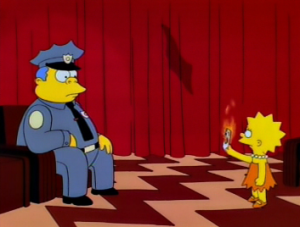
Simpsons did it.
I know from exploring magic that the young magician is often surprised by the sublime symbols found in unexpected places. A stray comment shatters a problem you had been hung up over for weeks, a book seems to correlate with a vision you had the night before, a television show seems like some sort of broadcast from fucked up Illuminati central. The last is how I felt when I was watching Twin Peaks for the first time.
ADVERTISEMENT
At the time I was finishing up the chapter in The Living Qabalah where the reader is exploring the concepts of Gerburah and Chesed before heading onto the Abyss. According to the mythology of Twin Peaks the Black Lodge opens up when Jupiter and Saturn meet. Jupiter, qabalistically represents the sphere of Chesed, whereas Saturn represents Binah. The space between the two spheres is not bridged by a path and the magician must dive from Chesed into the Abyss, between Jupiter and Saturn, and hope to come out on the other side. The Abyss is also the door to “other dimensions” and the key to what Kenneth Grant dubs “the Nightside of Eden.” The realm of the qlippoth, in a word, evil; the similarities to the Black Lodge are apparent. Now to survive the Abyss, or Daath, and the Black Lodge the magician must undergo a rigorous and too-easily-failed test. In the Qabalah it is complete and perfect ego loss, in Twin Peaks it is a test of courage…a wrestling match with the ugly parts of oneself. As one character, the stoic Deputy Hawk, the son of a Zuni shaman, says “there you will meet your own shadow self. My people call it ‘The Dweller on the Threshold.'” Actually the Dweller on the Threshold does not come from anybody resembling Hawk’s “people,” he is an American Indian, but is originally found in the writings of Edward Bulwer-Lytton (that is not to say that I know for sure there is no analogous figure in some tribal myths). Lord Lytton writes about the Dweller in his novel Zanoni, a lengthy book that Gary Lachman dubs a treasure-trove of occult knowledge. It is a somewhat cumbersome novel to the modern reader, though I enjoyed it enough; regrettably there aren’t very many good editions in print today.
Zanoni is the name of an immortal magician who the narrator persuades to teach him the ways of the mysteries. Tie this into the French Revolution, elements of opera, and a love affair and you have a novel that inspired Dickens’ ending to A Tale of Two Cities. In the book the Dweller is an entity, like Hawk explains “your shadow self”, that must be overcome through resolution and perfect bravery before further initiation. Like a commenter had pointed out on an earlier article; “fear is failure and the forerunner of failure.”
In his Dedalus Book of the Occult Lachman put forth the interesting theory that Lytton’s “Dweller” was based on his youthful depression and sense of isolation. Lytton was certainly involved with the occult and a few Rosicrucian societies active during his lifetime; he hobnobbed with Eliphas Levi when he crossed the channel and may have been present at the French magi’s evocation of the shade of Apollonius of Tyana. No matter where it came from the entity has been brought to the attention of would be mystic in the writings of Madame Blavatsky and other occultist ever since its inception. I’ve encounter a “dweller” once in a lucid dream; I didn’t realize what it was until I read about it in Lon Milo Duquette’s Low Magick. I’ll share with you what I wrote down for a friend in a collection of my encounters with “astral” beings.
“Later during the summer I had another encounter with these spaces. I entered into them differently however, through a doorway within a dream. During the dream I became aware that I was dreaming thanks to the usual rushing in the left ear and quickly returned to the bedroom when my body lay supine. Things took a terrifying turn at this point and I imagined/encountered some rabid being trying to get into the bedroom door. It screamed and howled and generally caused a fearful ruckus. As I girded myself to go and fight off the thing I work up completely with my girlfried shaking me. I had been screaming in my sleep.”- from “A Victim of the Higher Space: The Incident of the Angel and Other Phantoms.”
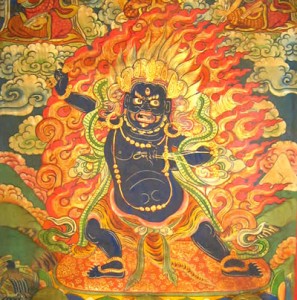
Duquette describes them as fearsome entities that are, in reality, or in whatever bizarre person’s conception of “reality” this is, perfectly harmless. He describes them as spirits, archetypes, whathaveyou, that have “sunk” from higher realms and now exist as empty cartridges. My meeting with one was unpleasant but it was nothing like what we’re led to believe happened in the Black Lodge. That is why I would posit the Ordeal of the Abyss is a closer analogy than the Dweller on the Threshold. Going back to our earlier discussion of Tibetan sorcery let’s consider Tibetan Buddhism. It is widely known to have a decidedly mystical bent compared to otherforms of Buddhism and is famous for the fascination it holds for many spiritual seekers. In the third episode after the pilot where much of the seeds for the Lodge system is set up Agent Cooper attempts to find a lead on Laura Palmer’s death in a peculiar manner. After a lecture on the country of Tibet, which he mentions throughout the series, he demonstrates his “Tibetan method” of deduction. This is based around a dream and mind/body coordination; it consists of throwing rocks at a bottle while an assistant recites the names of suspects. Whenever he hits the bottle it means they should investigate whoevers name had been called out last. This idiosyncratic detective method is part of what makes the show such a joy. In our world, David Lynch is a supporter for a free Tibet, and Cooper even states that before he dies he’d like to see an autonomous Tibet.
From what I’m told the best introductions to Tibetan Buddhism and the general sense of what make it unique is the Tibetan Book of the Dead or the Bardo Thodol. The book, which was immensely popular during the Sixties and was adapted by Timothy Leary into a manual for psychedelic trips, describes the events that the soul undergoes after death on its way to reincarnation. Another introduction would be anarchist and spiritual seeker Alexandra David-Neel’s fascinating account of her travels in Tibet, she was the first Westerner in Lhasa, Mystery and Magic in Tibet, available from Dover Books. Herein the reader may find some of the exoticism that attracts Lynch and Cooper to the mountainous country. Much of the Western conception of “magical Tibet” comes from the writings of Helena Petrovna Blavatsky who claimed to have met her Mahatmas, her masters and representatives of The Great White Lodge, there before coming to the West to disseminate her learning. While I’ve read very little of Blavatsky’s works I do know her famous, but again probably fictitious, Book of Dyzan is supposedly an ancient Tibetan text. Fragments of this work The Stanzas are included in her magnum opus The Secret Doctrine which is itself the sourcebook of Theosophy and a major text of occultism. If one is interested in these matters it may be worthwhile to look at The Mahatma Letters which is allegedly a collection of correspondences sent to Blavatsky and other leaders of the Theosophical Society from their “ascended masters.”
In the supplement book Welcome to Twin Peaks: An Access Guide to the Town a Theosophical Society is mentioned as being active in the town and holding meetings outside as well as eisteddvodai (Poetry Blow-outs). Pete Martell and the Log Lady are rumored to have been members and Agent Cooper was known to attend during his time in town. Another event mentioned in the supplement book is the Twin Peaks “Passion Play” where the players, sponsored by the Bookhouse Boys that Cooper and Sheriff Truman belong to, reenact the triumph of good over evil. The cast members are armed with the sword, chalice, crucifix, and chrysanthemum which I would hazard to guess is Lynch or the author’s reimagining of the Rose of western magic. They are confronted by a guardian who mysteriously appears and it goes on from there until the dawn breaks heralding the triumph of good. A classic initiation rite that takes place in April. April is the cruelest month… this is all fertile imagery drawn from Frazer’s Golden Bough, Rosicrucianism, and the mystery plays of the High Middle Ages that presented the stories of creation.
One early commentator I have found, who actually performed dream experiments using material from Twin Peaks believed that the Passion Play would be the concluding factor if the series had been allowed to continue. He has some pretty convincing arguments for this including a headline included elsewhere in the book “Mystery play saves Peaks season” that innocuously refers to the local Football team. Take into consideration that the Passion Play takes place at Glastonbury Grove, the entrance to the Black Lodge, and the assumption becomes more reasonable. Another group that is only mentioned in this book is the malignant Circular Lodge who are said to practice blood rites as well a ritual cannibalism. It is mentioned that they have a unique connection to Owl Cave, the place where the map of the Black Lodge was found, and occupied it during the fifties renaming it “Elk Cave”. Their origins, and where the accounts of their loathsome practice are derived, extend into the prehistory of Twin Peaks. Their belief in circular time and a moment of retribution may also hold a key to the nature of the dugpas and the Black Lodge. A haunting ad is placed in the Access Guide that confirms their continued existence and secrecy.
Another book which I don’t believe is mentioned anywhere in Twin Peaks that may be a good introduction to the White Lodge is Lost Horizon by James Hinton. A thoroughly enjoyable read, this is the book that introduced Shangri La to the world. Of course, Shangri La was based itself upon the mythical paradise of Shambhala. That said, it is also generally agreed upon by fans of the series that the White Lodge is not a physical location at all. After listening to Lynch’s Catching the Big Fish, my guess would be that the “White Lodge” is found in the depths of a Transcendental Meditation. At least, I imagine it would be there in Lynch’s estimation, considering he is a devotee of that movement. Started by the famous Maharishi Mahesh Yogi of the Beatles fame, it is often praised for its verifiable trance states and psychological affects, and conversely criticized for requiring payment from practitioners. As Annie Blackburn declares “teetotaling and prayer” and the cure for a hangover, I would prescribe “yoga and prayer” as the first step for anyone looking for peace or deeper meaning in life. Annie gives that advice to Cooper and Sheriff Truman while the two are eating and drinking coffee at the R. R. Diner. The Diner is a common theme and setting throughout the series and David Lynch has expressed his love of diners; “There’s a safety in thinking in a diner. You can have your coffee or your milkshake, and you can go off into strange dark areas, and always come back to the safety of the diner.” I think Greg and his crew would agree that there is definitely an aura to diners; they are a liminal area, often just dives at interstate stops or along the road, but also incredibly familiar, almost like you’re near home. I guess what I’m saying is there’s a magic to this particular piece of Americana to the weary and seeking soul.
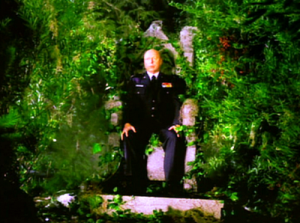 For UFO devotees there’s an interesting plot point that involves two of the most important characters in the show: Project Blue Book. Both Windom Earle, the human personification of evil, and Major Garland Briggs, the human personification of good, have been or are involved in the government investigation of anomalies. The real Project Blue Book was started in 1952 and ended in 1970, it also concerned itself solely with UFOs. It is still famous for being the only major, and public, government operation considering UFOs and for its small percentage of “unexplained” cases. It involved Dr. J. Allen Hyneck who designed the close encounter classification system and who is famous for being one of the few academics to take the UFO phenomenon seriously. Hyneck’s organization of scientists and academics took its name from Rosicrucian manifestos and societies; The Invisible College.
For UFO devotees there’s an interesting plot point that involves two of the most important characters in the show: Project Blue Book. Both Windom Earle, the human personification of evil, and Major Garland Briggs, the human personification of good, have been or are involved in the government investigation of anomalies. The real Project Blue Book was started in 1952 and ended in 1970, it also concerned itself solely with UFOs. It is still famous for being the only major, and public, government operation considering UFOs and for its small percentage of “unexplained” cases. It involved Dr. J. Allen Hyneck who designed the close encounter classification system and who is famous for being one of the few academics to take the UFO phenomenon seriously. Hyneck’s organization of scientists and academics took its name from Rosicrucian manifestos and societies; The Invisible College.
In the series Windom Earle goes mad while working for Blue Book; especially after his superiors won’t put any credence into his theories about the Black Lodge. Later, during the course of the show, Major Briggs approaches Agent Cooper and shows him a nonsensical radio transmission, ostensibly from deep space, that mentions his name and the phrase “the owls are not what they seem.” It later turns out that that particular transmission came from within the woods that surround the town of Twin Peaks. Briggs’ character is fascinating for his connection to the White Lodge and his mysterious role in the whole TP universe. He mysteriously disappears during the course of the series and reappears in just as strange a manner (wearing a forties era pilot’s uniform- possibly a reference to the pilots who have disappeared into the Bermuda Triangle) after an abduction into some transdimensional space. Later everything may hinge on Briggs and his unflappable sense of honor, duty, and goodness.
There are two more elements I’d like to cover. The first is a point I don’t think any other commentator has ever brought up. Throughout the show Cooper uses a voice recorder to recount his exploits, his suspicions, his random thoughts, all dictated to “Diane.” While a major presence in the show, Diane is never shown 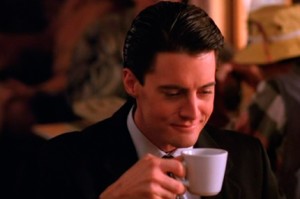 though the viewer automatically reasons she is Coop’s attached receptionist back at the Bureau. Diane, of course, is short for “Diana”; the Roman name of Artemis, the Greek Olympian Goddess of the Moon and the Hunt. When considering the Qabalah every god can be allocated to one of the ten spheres; Diana is heavily associated with Yesod, the realm of dreams and imagination. Now as any magician knows, imagination is very important. It is at times your world, the landscape that you interact with the achieve your goals, and it is sometimes your companion as well. You spend a lot of time with it and running thoughts through it. While I’m decently certain Lynch or Frost didn’t purposefully insert this into the series I would guess that “Diane” is Cooper’s imagination. He uses her to sort his thoughts, come up with the dreams and Tibetan methods that guide him, and as she is the goddess of the hunt she is instrumental in helping Cooper hunt down Laura’s killer, Earle, and BOB.
though the viewer automatically reasons she is Coop’s attached receptionist back at the Bureau. Diane, of course, is short for “Diana”; the Roman name of Artemis, the Greek Olympian Goddess of the Moon and the Hunt. When considering the Qabalah every god can be allocated to one of the ten spheres; Diana is heavily associated with Yesod, the realm of dreams and imagination. Now as any magician knows, imagination is very important. It is at times your world, the landscape that you interact with the achieve your goals, and it is sometimes your companion as well. You spend a lot of time with it and running thoughts through it. While I’m decently certain Lynch or Frost didn’t purposefully insert this into the series I would guess that “Diane” is Cooper’s imagination. He uses her to sort his thoughts, come up with the dreams and Tibetan methods that guide him, and as she is the goddess of the hunt she is instrumental in helping Cooper hunt down Laura’s killer, Earle, and BOB.
For the last bit we will, like the series, return to the Black Lodge and an account of sorcery that I stumbled across in Jorge Luis Borges and Co.’s The Book of Fantasy. It is a piece by William Butler Yeats who was a member of the Golden Dawn and heavily involved in magic in general. Titled The Sorcerers it is collected in Yeats’s Celtic Twilight as well; purportedly as fiction. I would easily declare that it is nothing of the sort, at least not in Yeats’s mind. It should be noted here that a toast from Yeats is recited earlier during the series by Pete Martell, wine comes in at the mouth. The piece is a short retelling of an encounter with some government clerks who also dabbled in black magic; the invoking of evil spirits to be exact. They take the poet to a location, not mind you their main location, where he witnesses them bring spirits into themselves. Though he refuses to be entranced as they are, an easily understood and countered process for a magician, he begins to feel the effects of their magic and must fight it off. He observes the schizoid behavior of the other magicians. When the ceremony is over he asked the “more powerful of the two sorcerers” a question. Before I tell you what the question is consider the job of the dark magi; they are clerks…utterly banal, much like the small town atmosphere of Twin Peaks in fact. For those who have seen the series the conclusion of Yeats’s story will make the end of that series as clear as day, at least for a moment.
“‘What would happen if one of your spirits had overpowered me?’ ‘You would go out of this room,’ he answered, ‘with his character added to your own.’” Think about that next time you see the final shot of the series and the final possession we are permitted to witness. Consider that we are the stuff that dreams are made of. It would therefore go to follow that we are able to manipulate or be manipulated by dreams themselves into visions of vitality. A work such as Twin Peaks crafted from surrealism, the hidden parts of man, and the influences discussed here is certainly a ripe work for exploration. While I wouldn’t try this with Wodehouse and I would indicate that no matter how hard you try with Harry Potter nothing will happen there are works, such as Lovecraft’s fiction that lend themselves to this unconscious transformation.
For more information on the series I’d check out what the Log Lady has to say as well as a couple of sites. Or check out Frost and Lynch’s series predecessor, the gnostic swinging sixties spy-fi The Prisoner. It would follow that Alan Moore’s new film Jimmy’s End, which is part of a large project titled The Show, draws deeply from Lynch’s series as an inspiration. There’s a lot more to discuss and find out for yourself. Note: After reading a small discourse on the connection between Twin Peaks and Whitley Strieber’s classic account of abduction Communion I had to share a the author’s conclusions. There is a lot of confusion when considering the nature of the owls in the series and their connection to the Lodges. Are they observers for the inhabitants, intermediate vessels, or disguises? The author points out that Strieber, before gaining any memory of what happened to him the night before, merely recalls a barn owl staring at him through the window that evening. He (or she) points out various other connections here. Taking into consideration that Communion is purportedly nonfiction and of great interest to the paranormal community this makes the implications of Twin Peaks all the more exciting.
It has been a pleasure speaking with you.
“We are certain that ancient, taloned bird sees what we do not, knows what we never will. And some night, silent as a gliding feather, its immensity will engulf us at fireside to tell us things we want to know as well as those we don’t. In the shadowed forest we’re pulled by that lurking and alluring ghost and we are enthralled.”- from Owlwise by Firelight
MORE GREAT STORIES FROM WEEK IN WEIRD:

-
Advertisement
Subscribe for the latest Weird News Delivered Daily!
Join the world’s only mobile paranormal museum!
World’s Weirdest News in your Social Feed!
Latest Stories
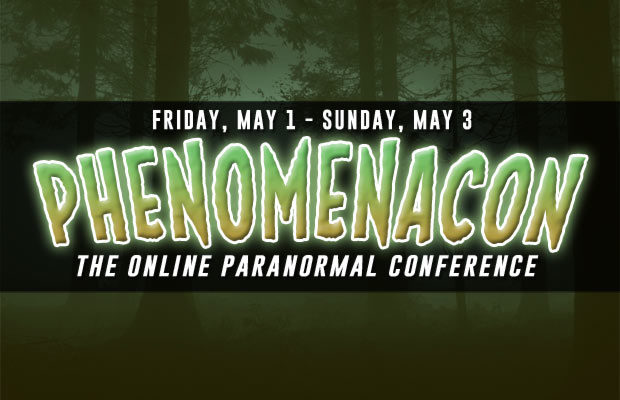
Phenomenacon: Attend the World’s First Online Paranormal Conference, Featuring Your Favorite Paranormal TV Stars
Martin Nelson | 04/22/2020With the onset of a global pandemic causing the shutdown of fan conventions all over the world, it was only a matter of time before the cancellations hit the...
2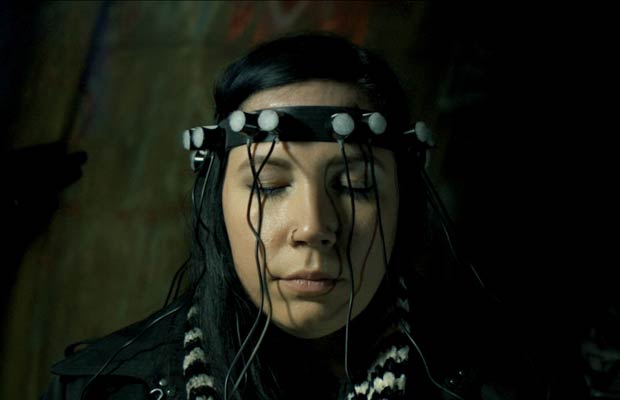
Groundbreaking Paranormal Documentary Series “Hellier” Returns with Ten Haunting Episodes of Appalachian Mystery
Martin Nelson | 11/28/2019There’s something strange moving through Kentucky like a virus, twisting through the Mammoth Cave system and hovering in the skies above the Appalachian Mountains. While might catch glimpses of...
2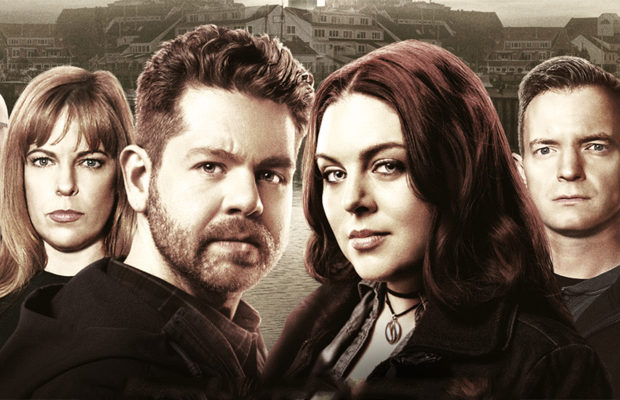
Travel Channel’s “Haunted Salem: Live” Features the “Paranormal Dream-Team” in Live, Four-Hour Ghost Hunt
Martin Nelson | 09/27/2019Travel Channel is kicking off Halloween season on October 4th with a very special live event that brings together more of the network’s top paranormal stars than you can...
2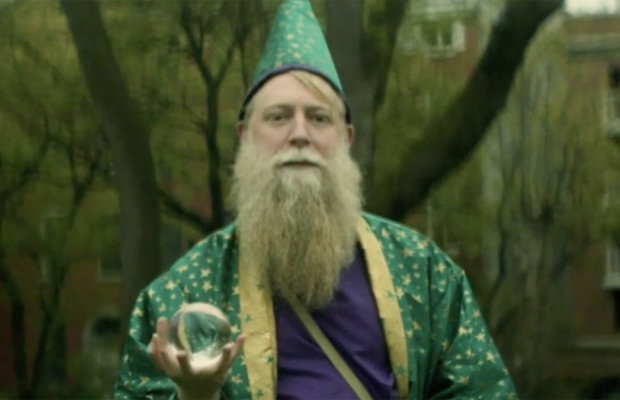
Meet Devin Person, a Real-Life Wizard Who Grants Wishes on the New York City Subway
Greg Newkirk | 06/11/2019For most of us, ignoring the strange people on the subway is second nature, but if you ever find yourself in the tunnels below New York City and you...
2Stories from Around the Internet
#PLANETWEIRD ON INSTAGRAM
About Week in Weird
Week In Weird is one of the web's most-visited destinations for all things weird, bringing you the latest fringe news, original articles featuring real investigations into unexplained phenomena, eyewitness reports of encounters with the anomalous, and interviews with notable figures in the fields of extra normal study.
Week In Weird is part of the Planet Weird family, brought to you by the paranormal adventures of Greg Newkirk and Dana Matthews, professional weirdos investigating the unexplained by engaging the strange.
- MORE ABOUT WEEK IN WEIRD
- REPORT A SIGHTING / CONTACT
- ADVERTISE WITH USFOLLOW PLANET WEIRD ON TWITTER
GREG & DANA: INVESTIGATING THE UNEXPLAINED
Content copyright © 2016 Planet Weird unless otherwise noted.


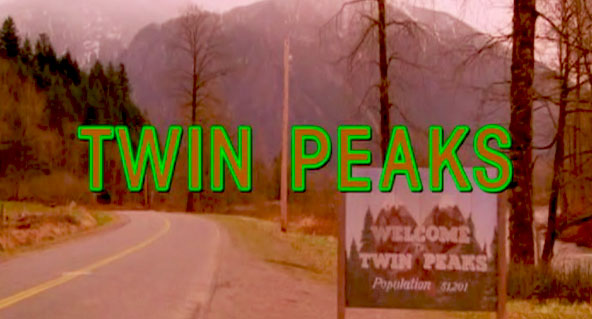
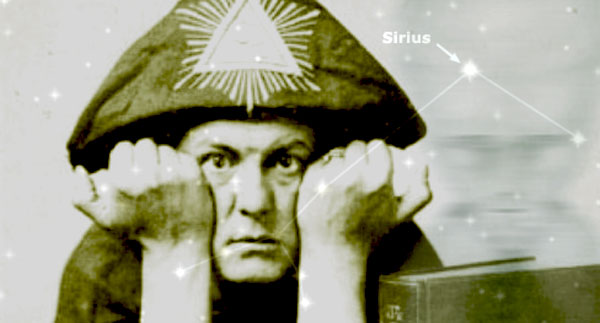
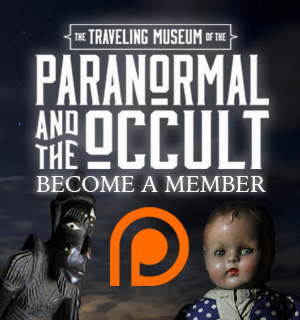

You must be logged in to post a comment Login